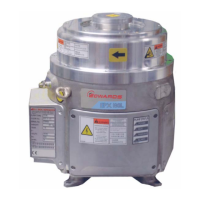© Edwards Limited 2007. All rights reserved. Page 61
Edwards and the Edwards logo are trademarks of Edwards Limited.
Storage and disposal
A419-00-880 Issue F
7 Storage and disposal
In the event of a pump seizure, dust is generated as a result of contact between the rotating and static surfaces.
This dust may contain aluminium sulphate in low concentrations and may be accompanied by a slightly
sulphurous smell.
It is recommended that when dealing with a pump which may have seized you wear gloves, eye protection and
a paper face mask.
7.1 Storage
When the pump is disconnected from the vacuum system, avoid contact with, or inhalation of any gases or
particulates that may still be present in the pump.
Store the pump as follows:
1. Ensure that the EPX has been shut down as described in Section 5, then disconnect the pump from the electrical
supply.
2. Allow the pump to cool for approximately 30 minutes before disconnecting the water to the pump. Drain the
water from the cooling circuit. Place a suitable container under the water outlet connector connection
(Figure 2, item 9) and connect a suitable connector along with a short length of hose for a drain. Fit an airline
(maximum pressure 100 psi) to a second spare connector and connect it to the pump water inlet connector
connection (Figure 2, item 4). Blow the water out of the cooling circuit then remove the drain fittings.
3. Disconnect the pump inlet (Figure 2, item 1) and pump exhaust (Figure 2, item 8) from the system.
4. Fit blanking caps to the pump inlet (Figure 2, item 1) and pump exhaust (Figure 2, item 8).
5. Store the pump in clean dry conditions until required.
6. When required for use, prepare and install the pump as described in Section 3 of this manual.
Lockout/tagout process delivery and the electrical and nitrogen purge supplies to the pump before
the pump is disconnected from the system.
Inlet and exhaust temperatures can exceed 65°C in a fault condition.

